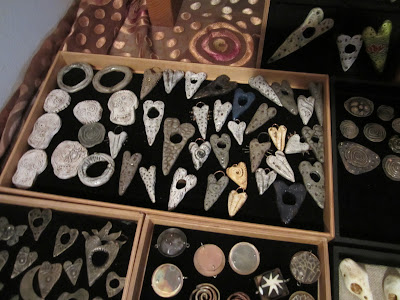Nichrome Wire and It's Use In Ceramic Bead Making.
Experiments with Cone 5 glaze firings using
Porcelain and Stoneware clay.
There is a lot of information out there on the web about it, so I'll avoid the boring details.
I will mention that it is an Alloy.
It contains nickel and chrome.
It is commercially available in various gauges and lengths and can withstand high temperatures,
which is it why ceramic and fused glass artists that use kilns like using it.
Three major things that I often hear about Nichrome in the jewelry world (and my answers):
1. It's Nickel - a lot of people are allergic.
*Yes - Nickel. Design smart and use it where it will not contact the skin directly*
2. It's not pretty. I like things shiny.
*The firing process oxidizes the metal, which looks green or dull. Sometimes it can be taken off with a green scrubby (see below). Think about how you clean rust off of steel wire used by glass bead makers.*
3. It can be brittle.
*Yes. Depending on the gauge of wire, how hot the kiln firing was, and how much the wire was "work hardened" after the firing may make the wire more susceptible to becoming brittle. Try not to over work it. The larger the wire, the more brittle it seems to become (Thanks Elaine Ray for our conversation about that).*
So here is my process of making
Porcelain and Stoneware Ceramic Headpins
with 24 ga Nichrome Wire:
Measure and cut wire ahead of time.
Insert wire into wet clay.
After clay is dry, bisque fire to Cone 04 (@1900 degrees F)
Glaze ceramic part, wipe off any glaze that remains on wire.
I like to suspend my beads.
This means figuring out the weight of the work and how much that ga wire can hold without slumping during the firing.
I've been doing this for 10+ years.
After a successful Cone 5 (@2230 Degrees F) Glaze firing,
I can easily bend the 24 ga Nichrome wire to "straight".
I then use a green scrubbie to clean the wire.
This is where you need to be careful to not overwork the wire as this action of cleaning and straightening is work hardening the wire.
I am able to make a quick simple wire wrapped bale with the 24 ga Nichrome wire with my normal tools (just like steel wire though, you might want to not use your "really good" tools).
Nichrome wire in my kiln.
The elements which are in the element holders of my L&L Kiln.
The Thermocouple
(green rod sticking out of the kiln wall at 1 o'clock).
The bead tree "rods" that come standard with these
Roselli Bead Racks.
The hooks I make with the 17 ga Kemper Hi Temp Wire to suspend my work.
And now - the 24 ga (and 22 ga) for making Ceramic Head Pins.
Some of the nichrome gets dark green,
while some stays just dull.
I keep noticing this and want to see why.
Maybe it is the ratio of nickel to chrome?
And then the after thought, which probably entered my mind at some point while making these:
Will they ship easily?
Did I waste wire by making them too long?
And as a bead maker there are questions:
1. How long of a wire do jewelry makers prefer? 2" or 3"or 5"?
I guess that depends on the project.
2. Do you prefer to receive your head pins ready to use?
Or should I not take extra time to clean them for you first?
Extra steps means extra time for either of us.
That of course is reflected in the price.
Either yours or mine.
I would tend to think in general people would want to receive them clean,
or at least somewhat clean with the oxidized green scale almost removed and ready to use.
And as a jewelry designer...
Well there are SO many things you could do!
Check out this post on what my "go to" jewelry designer friend Jenny Davies-Reazor quick whipped up for me with some of my head pins (we were discussing ways to "hide" the nichrome for issues #1, 2, and 3 above).
I'm going to experiment further and will post more next month here on LMAJ.
Hope to have lots more examples on use too...
4/23/15 Source update:
For those of you looking for nichrome wire there are a few good places to look.
I have ordered Kemper High Temp wire from my local ceramic supplier in the past.
I now order in larger quantities from
Jacobs Online (the Nichrome 60).
Hope this helps!













































